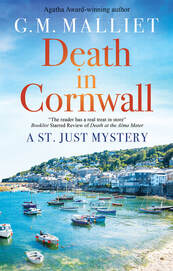Available now for preorder, Max Tudor #7 in paperback...
0 Comments
Most authors have a system for their writing. They jot every idea in a special notebook, and when they have dozens of notebooks they store them in a large box in the attic. I learned from watching a biography of J.K. Rowling that this is her method, except that she probably has to keep her notebooks in a bank vault.
Some authors scribble ideas on sticky notes that they attach to their study walls. The highly organized writer will code her sticky notes, giving each character and scene its own color. Sometimes the writer will show connected thoughts by stretching a piece of string from one note to another, often using colored twine that also carries some deep significance, so that before long the walls of the writer’s study look like the squad room of a murder investigation. When the author adds images of a character—photos cut from magazines and whatnot—the illusion of a real-life investigation is enhanced. Somehow a book comes out of all this. I am tempted to tell you that my books are written in just such an orderly and colorful way, in between hourly breaks for mindfulness meditation and yoga, and that WICKED AUTUMN and the following books in the Max Tudor series grew out of such fastidious planning and plotting. But the truth is my books emerge from chaos—a million bits and pieces of ideas, character descriptions, settings, and motives, all scribbled on whatever scrap of paper is to hand and stored in no particular order, with no brightly colored strings involved—a sort of Big Bang method of novel writing. Right now the worst part of my lack of method is that when asked to write about my inspiration for the Max Tudor series, I can only say, “I don’t really know.” That and, “I don’t remember.” Like most people, I am generally inspired by a looming car payment. But a book deadline becomes my lodestar, and I aim the good ship Max Tudor in that general direction and head off. Often without supplies or compass or life preserver, to continue the metaphor. But somehow in this process a book starts to emerge. My starting point is often the setting, which I can visualize almost to the last cobblestone. Nether Monkslip was largely inspired by my love of Agatha Christie’s Miss Marple and her St. Mary Mead, that much I do know. Then along came the characters to inhabit my village: suspects and victims. Someone must die! The why and the how are trickier, and are often inspired by some real-life case in the news. From there, anything I see, hear, touch, smell, or taste in the next nine to twelve months works its way into the story. All that said, as the first in the series, WICKED AUTUMN germinated for a very long time. Its protagonist Max Tudor is an Anglican priest and former MI5 agent, and he is loosely based on a CIA analyst of my acquaintance who is an Episcopal priest. Around the same time I met the analyst I met a pathologist who was also an Anglican priest. He happened to be a friend and consultant to P.D. James. I never knew these dual existences were possible, and it got me to thinking: What if? Max Tudor actually turns his back on being a spy when he goes to Oxford to begin the process of taking holy orders, but the “life” keeps calling him back and becomes a growing theme in the books as Max is called in, time and again, to solve a murder. Once I could picture a village like St. Mary Mead with its butchers and bakers and candlestick makers, and I had my handsome spy/priest, along came my imaginary woman in charge of the Women’s Institute in Nether Monkslip. I decided that Wanda would be bossy and awful to everyone, especially the group of hapless volunteers under her command. WICKED AUTUMN was the somehow inevitable result. I hope you enjoy reading the book as much as I enjoyed being able to bring it to you. BOOK CLUB QUESTIONS:
|
G.M. Malliet
.Agatha Award-winning author of the DCI St. Just mysteries, Max Tudor mysteries, standalone suspense novel WEYCOMBE, Augusta Hawke mysteries, and dozens of short stories. Books offered in all formats, including large print, e-Book, and audio. Archives
May 2024
|









 RSS Feed
RSS Feed